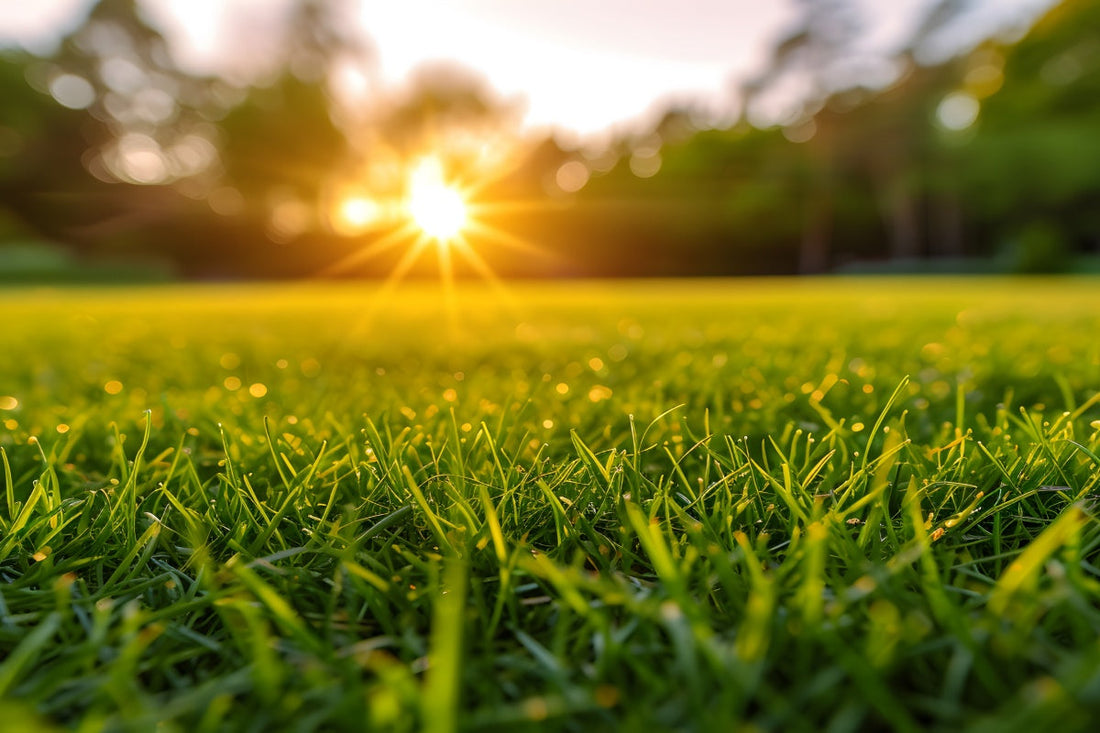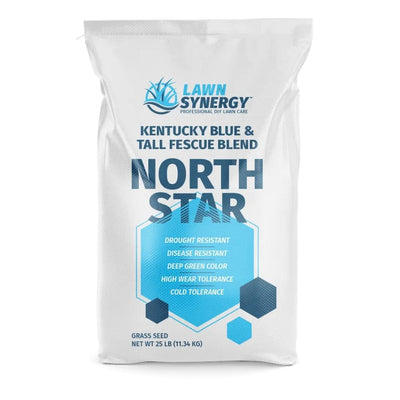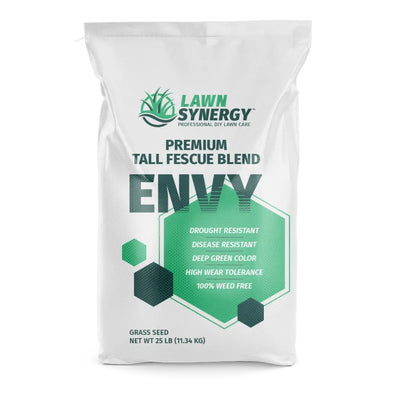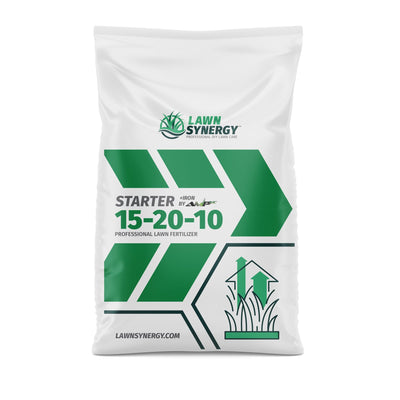Overseeding breathes life into tired turf, but only if you get the numbers right. If you're asking how much grass seed for overseeding, you're already thinking like a lawn care pro.
In this guide, we'll give you the exact rates, formulas, and best practices that Lawn Synergy clients use to restore density, color, and performance — without wasting seed or overdoing it.
What this article covers:
- What Is Overseeding?
- How Much Grass Seed Do You Need for Overseeding
- How to Measure and Prep Your Lawn Before Overseeding
- Seeding Rates by Grass Type: What Drives the Numbers
- Common Mistakes with Overseeding Rates
What Is Overseeding?
Overseeding means applying new grass seed directly into an existing lawn to fill bare spots, thicken thinning areas, or transition to a stronger variety.
Unlike starting from scratch, you're working with your current root system, leveraging what's healthy while upgrading the weak zones.
This method is especially useful for cool-season grasses like tall fescue and ryegrass that lose vigor over time. Overseeding boosts density, which reduces weed invasion, improves drought resilience, and enhances color.
When done with the right seed and at the right rate, it's one of the most cost-effective ways to rehab your lawn without tearing it up.

How Much Grass Seed Do You Need for Overseeding
The seeding rate for overseeding is lower than what you'd use for a new lawn. Because you already have a base canopy, the goal is to introduce new growth that blends seamlessly, not smother the existing turf.
Standard Overseeding Rate:
- 4 to 6 lbs per 1,000 sq. ft. for turf-type tall fescue
- 2 to 3 lbs per 1,000 sq. ft. for Kentucky bluegrass
- 5 to 8 lbs per 1,000 sq. ft. for perennial ryegrass
- 5 to 10 lbs per 1,000 sq. ft. for Bahia grass in southern zones
Multiply your lawn's square footage by the pounds-per-1,000-sq-ft rate, and you'll have the exact weight you need.
Example: For a 3,500 sq. ft. lawn using turf-type tall fescue at 5 lbs/1,000 sq. ft..:
3.5 × 5 = 17.5 lbs of seed
If you're unsure how much grass seed do I need in total, check out our in-depth guide.
How to Measure and Prep Your Lawn Before Overseeding
Correct measurement ensures you're not over- or under-applying your seed. Use a tape measure, wheel, or online tool to calculate your total lawn square footage.
Subtract driveways, patios, and landscape beds.
Next, focus on soil prep. Overseeding without prep is one of the top reasons for poor results.
Here's how to do it right:
- Mow low: Cut your existing lawn to about 1.5 inches and bag the clippings. This exposes the soil for better seed-to-soil contact.
- Dethatch or core aerate: Remove dead material or punch holes for seed entry and oxygen flow.
- Rake and level: Lightly rake the surface to break up clumps and spread seed evenly.
Right after seeding, water lightly two to three times daily to keep the top quarter-inch moist. For detailed irrigation advice, see our breakdown on how often to water grass seed.

Seeding Rates by Grass Type: What Drives the Numbers
Grass species vary not just in how they look, but in how they grow. And that's what determines the seeding rate.
Seed size, tillering ability, growth habit, and germination speed all impact how much seed you need to apply per 1,000 square feet. Here's what you need to know.
Tall Fescue
Rate: 4–6 lbs per 1,000 sq. ft.
Tall fescue has a larger seed size and low tiller production, meaning it doesn't spread aggressively on its own. You need a higher rate to achieve full coverage. Choose elite cultivars like HighGreen Turf-Type Tall Fescue for improved disease resistance and summer durability.
Perennial Ryegrass
Rate: 5–8 lbs per 1,000 sq. ft.
Ryegrass has fine seed and rapid germination (typically 5–7 days). It doesn't form rhizomes but offers fast initial coverage, making it excellent for overseeding warm-season lawns in fall or cool-season turf with thinning spots.
Kentucky Bluegrass
Rate: 2–3 lbs per 1,000 sq. ft.
Bluegrass has the smallest seed size and spreads through underground rhizomes, which means you can seed at lower rates but expect slower establishment (14–21 days to germinate). It's best used in northern climates or mixed into blends to aid self-repair over time.
Bahia Grass
Rate: 5–10 lbs per 1,000 sq. ft.
Bahia produces tough, drought-tolerant turf in sandy, acidic soils. Its seed has lower germination rates and longer establishment windows, which is why higher overseeding rates are often needed.
If you're looking into how to plant bahia grass seed, time your overseeding for mid to late spring when soil temps are reliably above 70°F.

Common Mistakes with Overseeding Rates
Even experienced DIYers can slip up on application rates. Too little seed, and you'll see no change. Too much, and you'll waste product and choke your lawn. Here's what to avoid:
- Overseeding too heavily: More isn't better. Overcrowding leads to poor airflow, fungal issues, and weak root systems. Dense mats of new seedlings often die back as competition increases.
- Inconsistent spreader calibration: If your lawn spreader isn't properly calibrated, you'll end up with streaks, patchy zones, or bare strips. Always check your settings against the seed bag's chart, and use a half-rate pattern in two passes (north-south, then east-west).
- Skipping fertilizer support: Overseeded seed needs nutrients to thrive. Apply a starter fertilizer like Starter 15-20-10 at the time of seeding to support root growth and early establishment.
- Avoid pre-emergent herbicides: If you're using a product like Guardian 13-0-10 Pre-Emergent, apply it before or well after seeding. Most pre-emergents prevent seed germination for up to 8 weeks.
Conclusion
Knowing how much grass seed for overseeding is the difference between a healthy rehab and a wasted effort. With accurate square footage, the right rate, and proper prep, you can thicken your turf, boost color, and defend against weeds — all without tearing up your yard.
At Lawn Synergy, we support DIY homeowners with professional-grade seed, fertilizer, and guidance that gets results.
Whether you're filling in bare spots or reviving a full lawn, we're here to help without the fluff, gimmicks, or overpriced service calls. Shop premium grass seed today and get in touch if you need any further help!
Ready to learn more about lawn care? Check out these articles:




